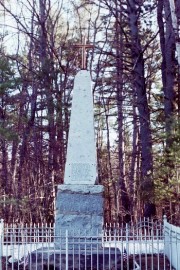1651-1774
Massachusetts asserts its claim to Maine and takes over in 1652. Royal commissioners set up an independent government in Maine in 166, but Massachusetts regains control in 1668. Many towns in Maine are incorporated during the period, developing a core of local government and for future resistance to Massachusetts.
1651
|
Massachusetts asserts its claim to Maine under its 1628 charter. |
1652 |
Massachusetts takes over Maine, York County established. Incorporation of the towns of Kittery and York. |
1653 |
Incorporation of the towns of Saco, Cape Porpoise, and Wells. |
1658 |
Incorporation of the towns of Scarborough and Falmouth. |
1661
|
Incorporation of the town of Apledoore, now part of Kittery. |
1664
|
Grant of the Province of Maine to James, Duke of York. |
1665 |
Royal commissioners set up an independent government in Maine. |
1668 |
Massachusetts government regains control of Maine. |
1674 |
Second Grant of the Province of Maine to James, Duke of York. County of Devonshire (east of the Kennebec) is established. |
1675 |
King Philip’s War begins. French Fort Pentagoet destroyed in Castine by the Dutch. |
1677
|
Massachusetts buys the claims of Sir Fernando Gorges‘ heirs. |
1678 |
Sir Edmund Andros, under the Duke of York, becomes governor of New York and Sagadahoc. |
1680 |
Government of Maine reorganized by the Massachusetts General Court. |
1683 |
Incorporation of the town of North Yarmouth. |
1685 |
British create the position of Surveyor of Pines and Timber in Maine to identify tall pines for the Royal Navy |
1687 |
Sir Edmund Andros becomes governor of New England. |
1688 |
King William’s War begins, lasting until 1699, destroying most Maine settlements. Edward Randolph makes first survey of Maine. |
1689 |
Andros, who precipitated King William’s War, is deposed. |
1691 |
Massachusetts Charter given by William and Mary designates Maine a “District.” Charter reserves to the Crown all pines 24 or more inches in diameter and 12 inches above the ground. |
1692 |
Serious Indian raids on Maine; York “massacre” occurs. |
1699 |
Norridgewock Indians sign truce ending King William’s War. |
1703 |
Queen Anne’s or Third Indian War, 1703-1711; settlements ravaged. |
1704
|
Colonel Church attacks Indians up the Penobscot River, and the coast to the east. |
1713
|
French cede Acadia (eastern Maine) to the English. Incorporation of the town of Berwick. |
1715 |
The new owner of the Pejepscot purchase petitions the Massachusetts General Court for approval and support to create three new towns: Brunswick, Topsham, and Harpswell. |
1716 |
Incorporation of the town of Georgetown. |
1718 |
Samuel Bellamy’s brief pirate “republic” at Machias. Incorporation of the towns of Falmouth and Biddeford. |
1719 |
Incorporation of the town of Arundel. |
17221724 |
In the first violence of the 4th Indian War, nine families were seized on the northern end of Merrymeeting Bay. Most were soon released; others were held to trade for hostages held by the British. Fearing the French influence among the Indians to be a threat to their claims on the land, the British attacked a Native American settlement in Norridgewock, massacring most of the residents, including Jesuit missionary Father Rasle. |
1725 |
Bloody battle of Lovewell’s Pond defeats Sokokis Indians, protects settlers. |
1729 |
The Surveyor of Pines and Timber is directed to mark as property of the Crown such pines of more than 24 inch diameter as he should deem fit for Naval masts, causing resentment among colonists working the forests. |
1733 |
Slavery, an accepted practice in the colonies, documented in York. |
1739 |
Incorporation of the town of Brunswick. Dam built at Saccarappa Falls without fish passage. Chief Polin of Aucocisco tribe walks to Boston to complain to Governor Shirley about dam’s impact on migratory fish runs. People of Westbrook request that fishway be built at Saccarappa Falls dam. |
1741 |
New Hampshire becomes separate province; border with Maine is established. |
1742 |
Population of Maine is estimated at 12,000. |
1745
|
French Fort Louisbourg, on Cape Breton Island in eastern Canada, used to harass colonists, is captured by William Pepperrell. |
1750 |
Population of Maine is estimated at 10,000. |
1754 |
Seven Years’ War, the last of the French and Indian Wars begins. |
1759 |
Fort Pownall in Stockton Springs constructed. |
1760
|
Cumberland and Lincoln Counties formed.Incorporation of the town of Pownalborough. Population of Maine is estimated at 12,000. |
1761
|
Pownalborough Courthouse is the first built in Maine and the only one built prior to the Revolution. Birth of Edward Preble, “Father of the U.S. Navy” and Commander of U.S. naval forces during much of the Tripolitan War, 1801-1805. First settlement in the town of Mount Desert. |
1762 |
Incorporation of the towns of Windham and Bowdoinham. |
1763 |
In the Treaty of Paris, France surrenders all claims to North America; Seven Years’ War ends. |
1764 |
Joseph Chadwick records first non-native sighting of Mount Katahdin. Incorporation of the towns of Topsham, Gorham, and Boothbay. |
1765 |
John Adams, a young lawyer and future U.S. President, tries a case at the Pownalborough Courthouse, now in Dresden.Incorporation of the town of Bristol. |
1767
|
Incorporation of the town of Lebanon. |
1768 |
Birth of Jonathan Fisher, minister, inventor, farmer, architect and builder, surveyor, linguist, naturalist. Incorporation of the Town of Sanford. |
1770 |
Population of Maine: 31,257. |
1771 |
Incorporation of the towns of Hallowell, Vassalborough, Winslow, Winthrop. |
1772 |
Incorporation of the town of Buxton. |
1773 |
Incorporation of the town of Waldoborough and Belfast. |
1774 |
Incorporation of the towns of New Gloucester and Edgecomb.First Continental Congress convenes in Philadelphia. |
PREVIOUS SECTION – – – – – – – – – – – – – – – NEXT SECTION


